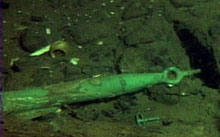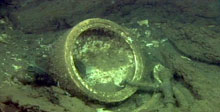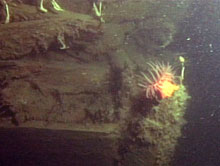
This green object is probably a brass patent log that would be towed from the ship to determine its speed. Image courtesy NOAA/NURC-UConn/The Science Channel. Click image for larger view.
Investigating a Mystery Ship
Sept. 18, 2003
Deborah Marx
Maritime Archaeologist
Landfall Archaeological Resource Consultants
Today’s mission centered on the ROV (remotely operated vehicle) investigation of a mystery wreck in 400 ft of water. Researchers from the Stellwagen Bank National Marine Sanctuary first located the wreck with sidescan sonar in October 2002. Local fishermen originally provided the sanctuary with the wreck's coordinates.
The R/V Connecticut arrived on site at approximately 8:30 am and launched the ROV Hela without delay. As Hela headed down to the sea floor, the team assembled in the control van to await the appearance of the mystery wreck on the monitor.
This was my first investigation of a wreck site with an ROV, so I was anxiously anticipating what type of vessel the mystery wreck might be. Together with Matthew Lawrence and Ben Cowie-Haskell, I saw a wood- hulled vessel surrounded by a debris field of coal appear in the monitor, and the level of excitement in the control van heightened.

This item, found at the stern of the mystery ship, may have been the captain’s toilet. Image courtesy NOAA/NURC-UConn/The Science Channel. Click image for larger view.
Our investigation began with examining the end of the wreck to determine if it was the stem or stern. After several minutes of debate the team identified the southern-facing end as the stern because of its shape and construction. A ceramic toilet bowl sheathed in copper lies on the sea floor just outside the vessel’s stern, a clear sign that the team correctly identified the stern because only the captain’s quarters in the stern would contain such a luxury item.
Next, Hela headed down the portside of the vessel. The wreck’s lower hull is intact, and copper sheathing, as well as frames, inner and outer hull planking, and copper alloy fastenings were clearly visible. The team noted such features as frame spacing and the presence of numerous intact knees as Hela traversed the length of the wreck. After close inspection and identification of the bow, the ROV headed down the outside of the wreck’s starboard side.

A chrysanthemum-like anemone and a tulip-like boltenia are actually benthic (sea-floor) animals. They have attached themselves to the bow of the mystery ship. Image courtesy NOAA/NURC-UConn/The Science Channel.Click image for larger view.
The hull is intact from the keel up to deck level and the team even identified intact deck planking as well as hanging and lodging knees throughout the vessel. The most exciting moment of the investigation came when the ROV encountered a cluster of artifacts in the aft portion of the vessel, probably located in the area of the deck cabin. The ROV transmitted images of several clay pipes, glass bottles, brass gears from a clock, a key, ceramic teacups, and most exciting of all, a brass patent log used to measure the ship’s speed. These diagnostic artifacts may help us determine the wreck's identity.
At this point, certain conclusions can be drawn. Our mystery ship was a wood-hulled sailing vessel that carried a cargo of coal along the East Coast during the last quarter of the 19th century. It is even possible that the ship wrecked during the Portland Gale of 1898.

















